DAFNE Implementation Proposal: Curtin Health Service
VerifiedAdded on 2022/09/01
|9
|2382
|16
Report
AI Summary
This report presents a literature review focused on the Dose Adjustment For Normal Eating (DAFNE) program, a structured education intervention for managing Type 1 diabetes mellitus (T1DM). The review synthesizes research highlighting the effectiveness of DAFNE in improving self-management, insulin dosage adjustments, glycemic control, and overall quality of life for diabetic patients. The literature emphasizes the importance of flexible dieting, carbohydrate estimation, and insulin ratios. The report also addresses challenges such as the need for literacy and numeracy skills and the importance of follow-up support. Based on the evidence, the report proposes the implementation of the DAFNE program within the Curtin Health Service in Perth, Western Australia, to address the increasing prevalence of T1DM, reduce hospital admissions, and improve patient outcomes. The proposal underscores the program's cost-effectiveness, ability to instill self-confidence, and potential for long-term benefits through reduced complications and improved quality of life. The report also recommends follow-up activities to ensure the sustained application of DAFNE principles.
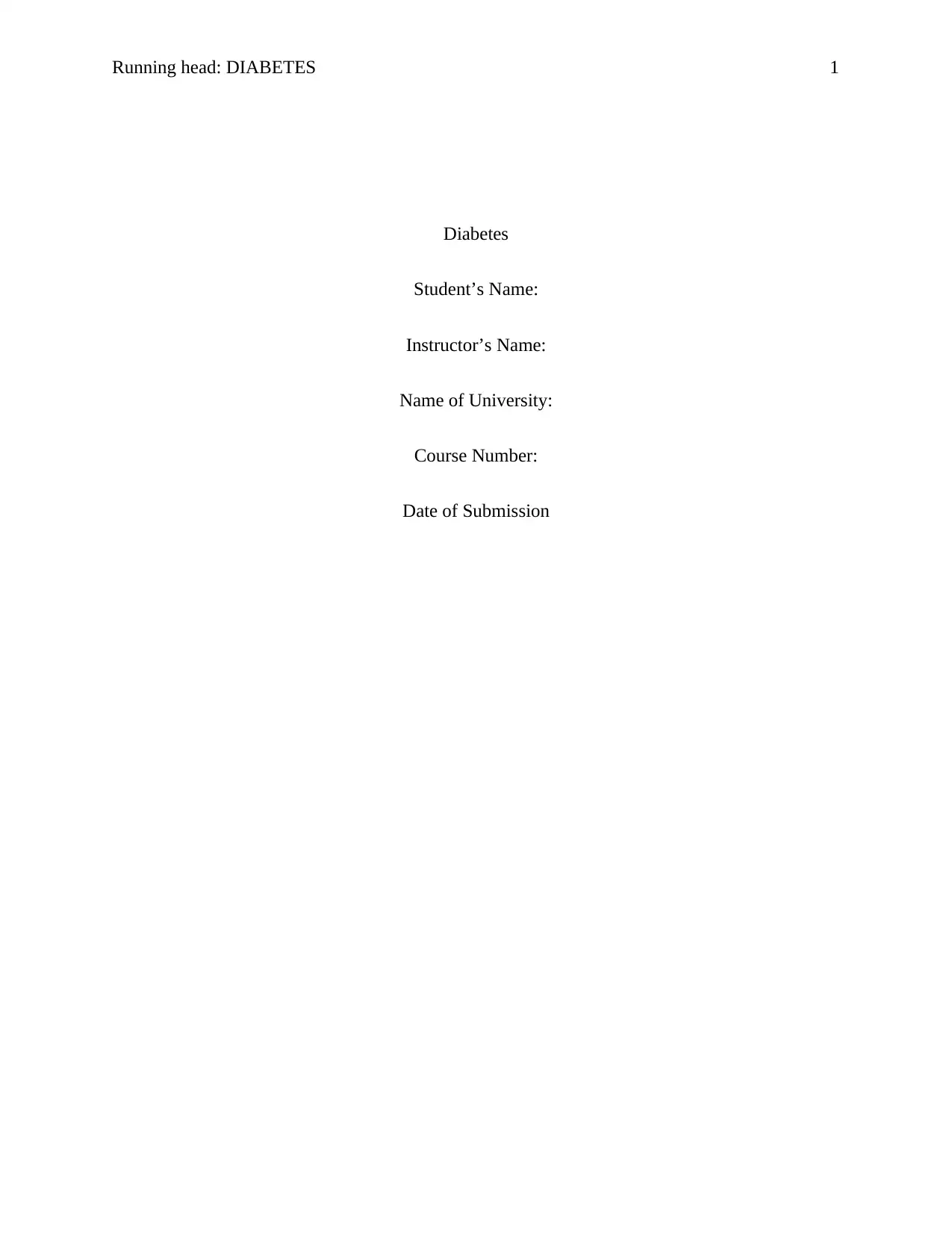
Running head: DIABETES 1
Diabetes
Student’s Name:
Instructor’s Name:
Name of University:
Course Number:
Date of Submission
Diabetes
Student’s Name:
Instructor’s Name:
Name of University:
Course Number:
Date of Submission
Paraphrase This Document
Need a fresh take? Get an instant paraphrase of this document with our AI Paraphraser
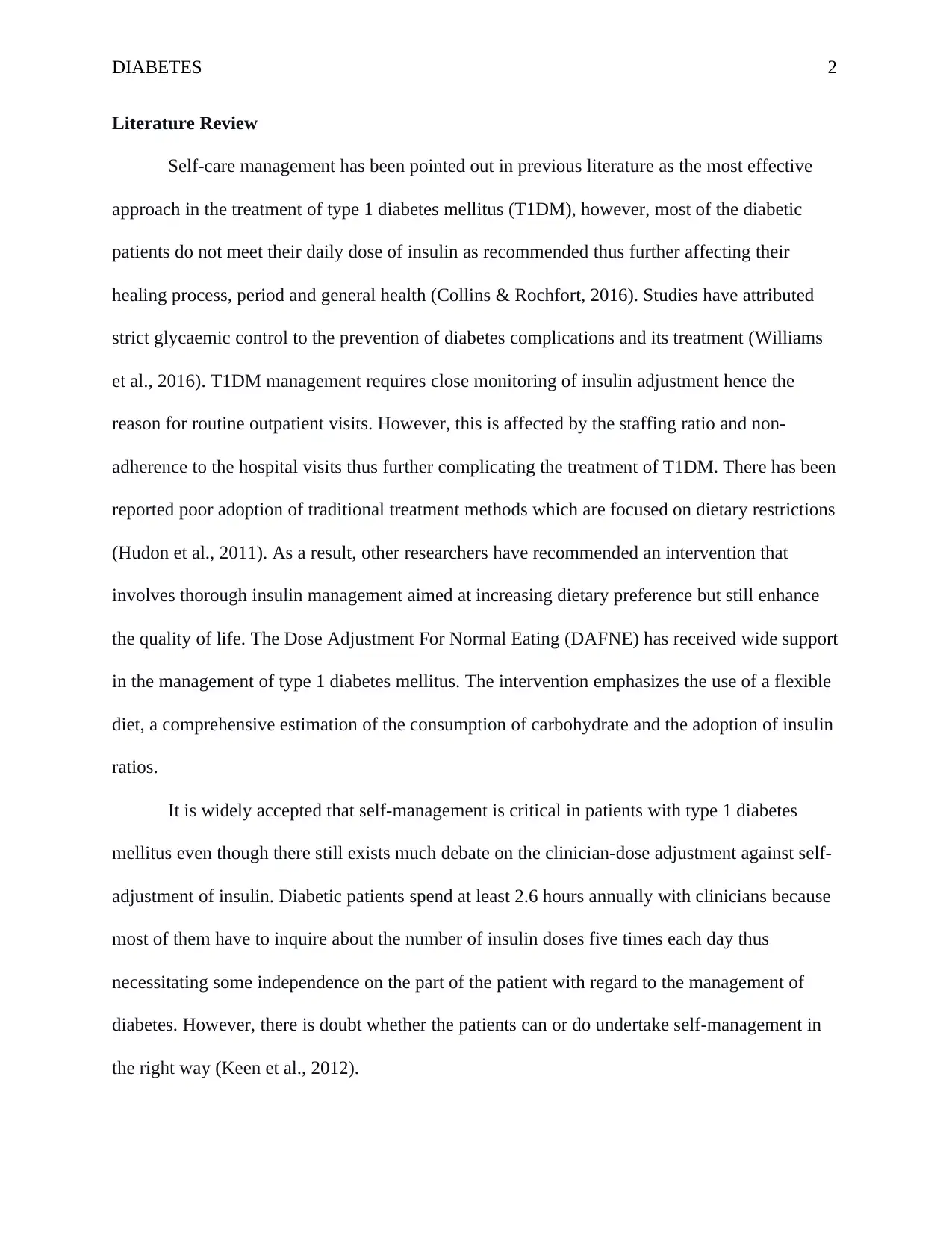
DIABETES 2
Literature Review
Self-care management has been pointed out in previous literature as the most effective
approach in the treatment of type 1 diabetes mellitus (T1DM), however, most of the diabetic
patients do not meet their daily dose of insulin as recommended thus further affecting their
healing process, period and general health (Collins & Rochfort, 2016). Studies have attributed
strict glycaemic control to the prevention of diabetes complications and its treatment (Williams
et al., 2016). T1DM management requires close monitoring of insulin adjustment hence the
reason for routine outpatient visits. However, this is affected by the staffing ratio and non-
adherence to the hospital visits thus further complicating the treatment of T1DM. There has been
reported poor adoption of traditional treatment methods which are focused on dietary restrictions
(Hudon et al., 2011). As a result, other researchers have recommended an intervention that
involves thorough insulin management aimed at increasing dietary preference but still enhance
the quality of life. The Dose Adjustment For Normal Eating (DAFNE) has received wide support
in the management of type 1 diabetes mellitus. The intervention emphasizes the use of a flexible
diet, a comprehensive estimation of the consumption of carbohydrate and the adoption of insulin
ratios.
It is widely accepted that self-management is critical in patients with type 1 diabetes
mellitus even though there still exists much debate on the clinician-dose adjustment against self-
adjustment of insulin. Diabetic patients spend at least 2.6 hours annually with clinicians because
most of them have to inquire about the number of insulin doses five times each day thus
necessitating some independence on the part of the patient with regard to the management of
diabetes. However, there is doubt whether the patients can or do undertake self-management in
the right way (Keen et al., 2012).
Literature Review
Self-care management has been pointed out in previous literature as the most effective
approach in the treatment of type 1 diabetes mellitus (T1DM), however, most of the diabetic
patients do not meet their daily dose of insulin as recommended thus further affecting their
healing process, period and general health (Collins & Rochfort, 2016). Studies have attributed
strict glycaemic control to the prevention of diabetes complications and its treatment (Williams
et al., 2016). T1DM management requires close monitoring of insulin adjustment hence the
reason for routine outpatient visits. However, this is affected by the staffing ratio and non-
adherence to the hospital visits thus further complicating the treatment of T1DM. There has been
reported poor adoption of traditional treatment methods which are focused on dietary restrictions
(Hudon et al., 2011). As a result, other researchers have recommended an intervention that
involves thorough insulin management aimed at increasing dietary preference but still enhance
the quality of life. The Dose Adjustment For Normal Eating (DAFNE) has received wide support
in the management of type 1 diabetes mellitus. The intervention emphasizes the use of a flexible
diet, a comprehensive estimation of the consumption of carbohydrate and the adoption of insulin
ratios.
It is widely accepted that self-management is critical in patients with type 1 diabetes
mellitus even though there still exists much debate on the clinician-dose adjustment against self-
adjustment of insulin. Diabetic patients spend at least 2.6 hours annually with clinicians because
most of them have to inquire about the number of insulin doses five times each day thus
necessitating some independence on the part of the patient with regard to the management of
diabetes. However, there is doubt whether the patients can or do undertake self-management in
the right way (Keen et al., 2012).
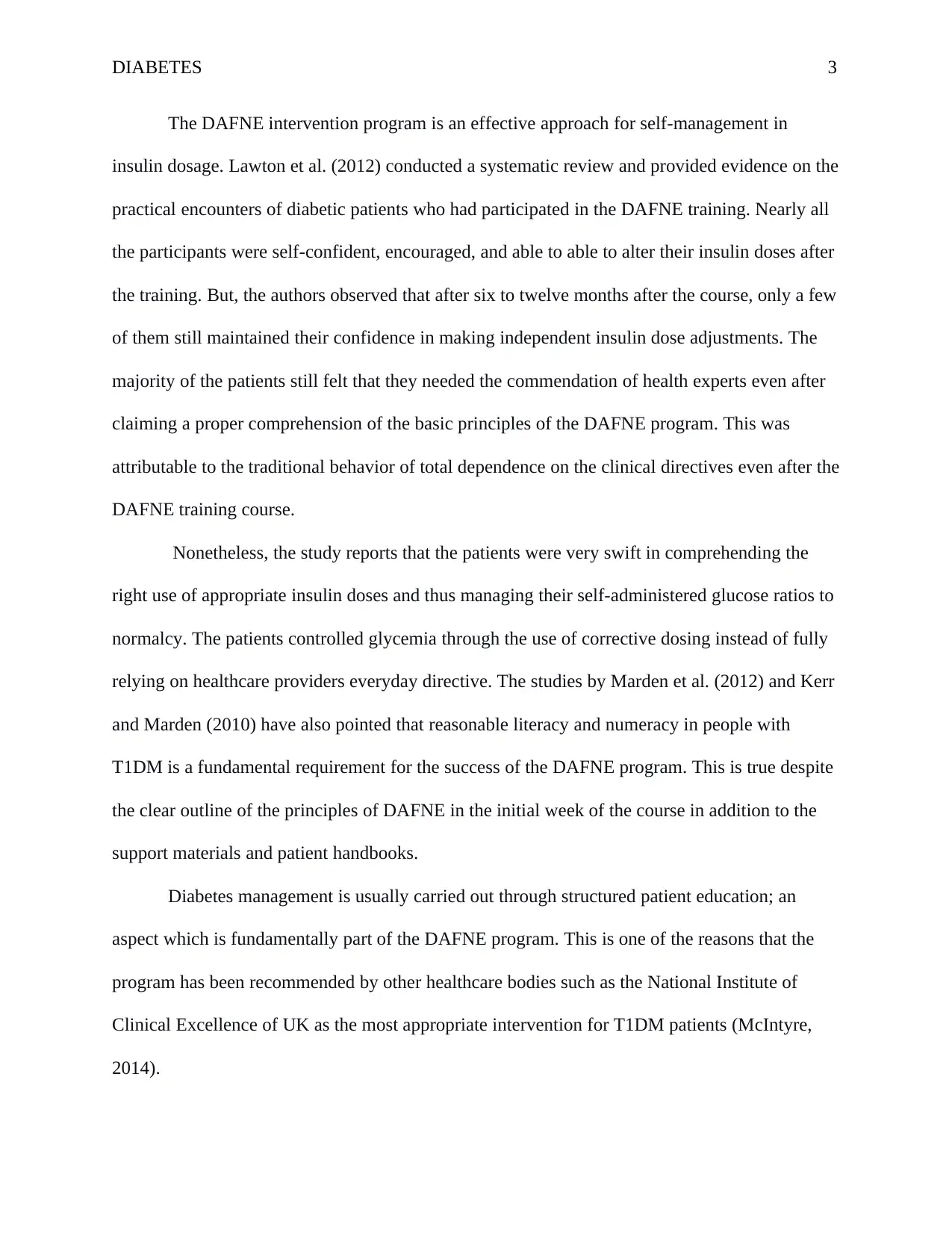
DIABETES 3
The DAFNE intervention program is an effective approach for self-management in
insulin dosage. Lawton et al. (2012) conducted a systematic review and provided evidence on the
practical encounters of diabetic patients who had participated in the DAFNE training. Nearly all
the participants were self-confident, encouraged, and able to able to alter their insulin doses after
the training. But, the authors observed that after six to twelve months after the course, only a few
of them still maintained their confidence in making independent insulin dose adjustments. The
majority of the patients still felt that they needed the commendation of health experts even after
claiming a proper comprehension of the basic principles of the DAFNE program. This was
attributable to the traditional behavior of total dependence on the clinical directives even after the
DAFNE training course.
Nonetheless, the study reports that the patients were very swift in comprehending the
right use of appropriate insulin doses and thus managing their self-administered glucose ratios to
normalcy. The patients controlled glycemia through the use of corrective dosing instead of fully
relying on healthcare providers everyday directive. The studies by Marden et al. (2012) and Kerr
and Marden (2010) have also pointed that reasonable literacy and numeracy in people with
T1DM is a fundamental requirement for the success of the DAFNE program. This is true despite
the clear outline of the principles of DAFNE in the initial week of the course in addition to the
support materials and patient handbooks.
Diabetes management is usually carried out through structured patient education; an
aspect which is fundamentally part of the DAFNE program. This is one of the reasons that the
program has been recommended by other healthcare bodies such as the National Institute of
Clinical Excellence of UK as the most appropriate intervention for T1DM patients (McIntyre,
2014).
The DAFNE intervention program is an effective approach for self-management in
insulin dosage. Lawton et al. (2012) conducted a systematic review and provided evidence on the
practical encounters of diabetic patients who had participated in the DAFNE training. Nearly all
the participants were self-confident, encouraged, and able to able to alter their insulin doses after
the training. But, the authors observed that after six to twelve months after the course, only a few
of them still maintained their confidence in making independent insulin dose adjustments. The
majority of the patients still felt that they needed the commendation of health experts even after
claiming a proper comprehension of the basic principles of the DAFNE program. This was
attributable to the traditional behavior of total dependence on the clinical directives even after the
DAFNE training course.
Nonetheless, the study reports that the patients were very swift in comprehending the
right use of appropriate insulin doses and thus managing their self-administered glucose ratios to
normalcy. The patients controlled glycemia through the use of corrective dosing instead of fully
relying on healthcare providers everyday directive. The studies by Marden et al. (2012) and Kerr
and Marden (2010) have also pointed that reasonable literacy and numeracy in people with
T1DM is a fundamental requirement for the success of the DAFNE program. This is true despite
the clear outline of the principles of DAFNE in the initial week of the course in addition to the
support materials and patient handbooks.
Diabetes management is usually carried out through structured patient education; an
aspect which is fundamentally part of the DAFNE program. This is one of the reasons that the
program has been recommended by other healthcare bodies such as the National Institute of
Clinical Excellence of UK as the most appropriate intervention for T1DM patients (McIntyre,
2014).
⊘ This is a preview!⊘
Do you want full access?
Subscribe today to unlock all pages.

Trusted by 1+ million students worldwide
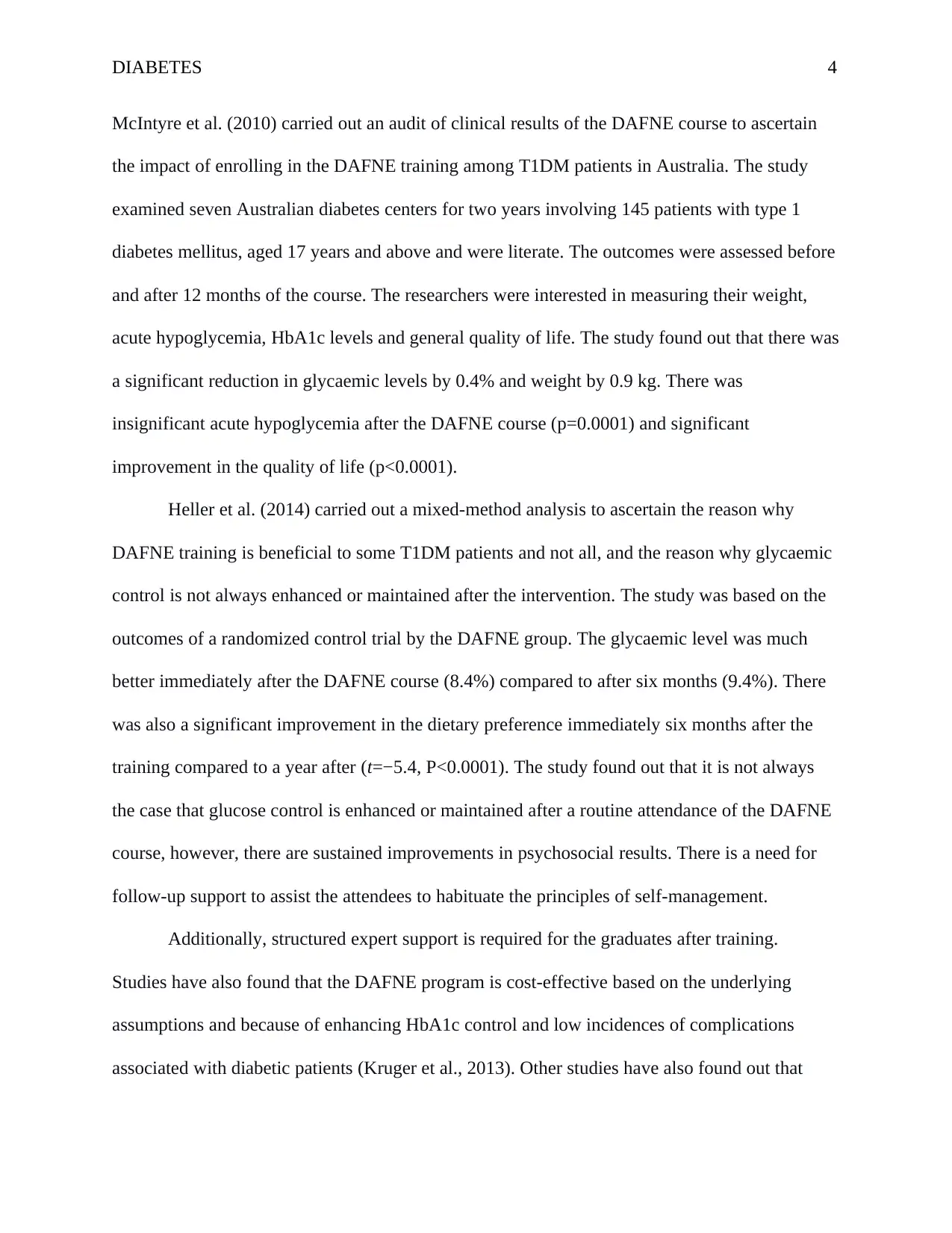
DIABETES 4
McIntyre et al. (2010) carried out an audit of clinical results of the DAFNE course to ascertain
the impact of enrolling in the DAFNE training among T1DM patients in Australia. The study
examined seven Australian diabetes centers for two years involving 145 patients with type 1
diabetes mellitus, aged 17 years and above and were literate. The outcomes were assessed before
and after 12 months of the course. The researchers were interested in measuring their weight,
acute hypoglycemia, HbA1c levels and general quality of life. The study found out that there was
a significant reduction in glycaemic levels by 0.4% and weight by 0.9 kg. There was
insignificant acute hypoglycemia after the DAFNE course (p=0.0001) and significant
improvement in the quality of life (p<0.0001).
Heller et al. (2014) carried out a mixed-method analysis to ascertain the reason why
DAFNE training is beneficial to some T1DM patients and not all, and the reason why glycaemic
control is not always enhanced or maintained after the intervention. The study was based on the
outcomes of a randomized control trial by the DAFNE group. The glycaemic level was much
better immediately after the DAFNE course (8.4%) compared to after six months (9.4%). There
was also a significant improvement in the dietary preference immediately six months after the
training compared to a year after (t=−5.4, P<0.0001). The study found out that it is not always
the case that glucose control is enhanced or maintained after a routine attendance of the DAFNE
course, however, there are sustained improvements in psychosocial results. There is a need for
follow-up support to assist the attendees to habituate the principles of self-management.
Additionally, structured expert support is required for the graduates after training.
Studies have also found that the DAFNE program is cost-effective based on the underlying
assumptions and because of enhancing HbA1c control and low incidences of complications
associated with diabetic patients (Kruger et al., 2013). Other studies have also found out that
McIntyre et al. (2010) carried out an audit of clinical results of the DAFNE course to ascertain
the impact of enrolling in the DAFNE training among T1DM patients in Australia. The study
examined seven Australian diabetes centers for two years involving 145 patients with type 1
diabetes mellitus, aged 17 years and above and were literate. The outcomes were assessed before
and after 12 months of the course. The researchers were interested in measuring their weight,
acute hypoglycemia, HbA1c levels and general quality of life. The study found out that there was
a significant reduction in glycaemic levels by 0.4% and weight by 0.9 kg. There was
insignificant acute hypoglycemia after the DAFNE course (p=0.0001) and significant
improvement in the quality of life (p<0.0001).
Heller et al. (2014) carried out a mixed-method analysis to ascertain the reason why
DAFNE training is beneficial to some T1DM patients and not all, and the reason why glycaemic
control is not always enhanced or maintained after the intervention. The study was based on the
outcomes of a randomized control trial by the DAFNE group. The glycaemic level was much
better immediately after the DAFNE course (8.4%) compared to after six months (9.4%). There
was also a significant improvement in the dietary preference immediately six months after the
training compared to a year after (t=−5.4, P<0.0001). The study found out that it is not always
the case that glucose control is enhanced or maintained after a routine attendance of the DAFNE
course, however, there are sustained improvements in psychosocial results. There is a need for
follow-up support to assist the attendees to habituate the principles of self-management.
Additionally, structured expert support is required for the graduates after training.
Studies have also found that the DAFNE program is cost-effective based on the underlying
assumptions and because of enhancing HbA1c control and low incidences of complications
associated with diabetic patients (Kruger et al., 2013). Other studies have also found out that
Paraphrase This Document
Need a fresh take? Get an instant paraphrase of this document with our AI Paraphraser
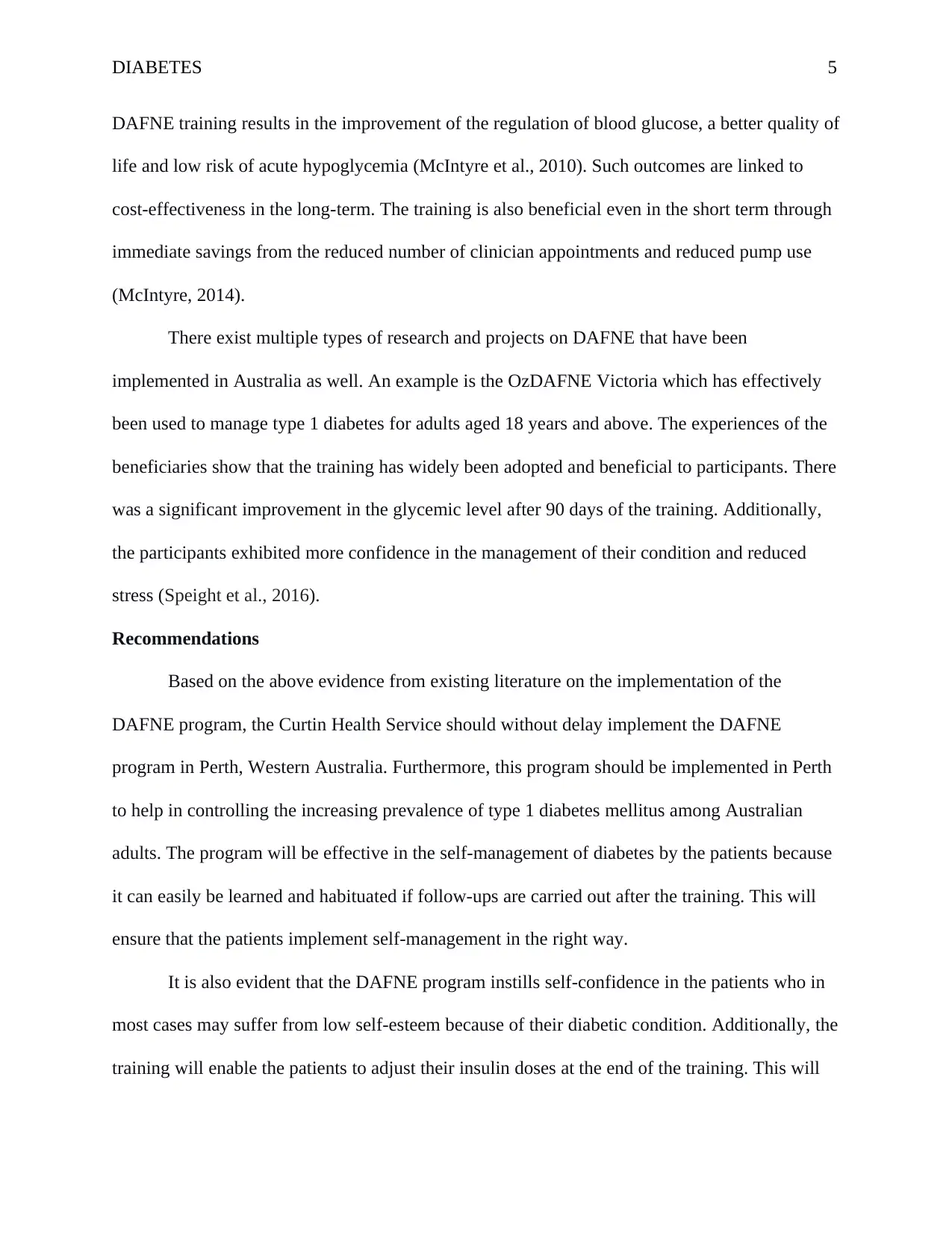
DIABETES 5
DAFNE training results in the improvement of the regulation of blood glucose, a better quality of
life and low risk of acute hypoglycemia (McIntyre et al., 2010). Such outcomes are linked to
cost-effectiveness in the long-term. The training is also beneficial even in the short term through
immediate savings from the reduced number of clinician appointments and reduced pump use
(McIntyre, 2014).
There exist multiple types of research and projects on DAFNE that have been
implemented in Australia as well. An example is the OzDAFNE Victoria which has effectively
been used to manage type 1 diabetes for adults aged 18 years and above. The experiences of the
beneficiaries show that the training has widely been adopted and beneficial to participants. There
was a significant improvement in the glycemic level after 90 days of the training. Additionally,
the participants exhibited more confidence in the management of their condition and reduced
stress (Speight et al., 2016).
Recommendations
Based on the above evidence from existing literature on the implementation of the
DAFNE program, the Curtin Health Service should without delay implement the DAFNE
program in Perth, Western Australia. Furthermore, this program should be implemented in Perth
to help in controlling the increasing prevalence of type 1 diabetes mellitus among Australian
adults. The program will be effective in the self-management of diabetes by the patients because
it can easily be learned and habituated if follow-ups are carried out after the training. This will
ensure that the patients implement self-management in the right way.
It is also evident that the DAFNE program instills self-confidence in the patients who in
most cases may suffer from low self-esteem because of their diabetic condition. Additionally, the
training will enable the patients to adjust their insulin doses at the end of the training. This will
DAFNE training results in the improvement of the regulation of blood glucose, a better quality of
life and low risk of acute hypoglycemia (McIntyre et al., 2010). Such outcomes are linked to
cost-effectiveness in the long-term. The training is also beneficial even in the short term through
immediate savings from the reduced number of clinician appointments and reduced pump use
(McIntyre, 2014).
There exist multiple types of research and projects on DAFNE that have been
implemented in Australia as well. An example is the OzDAFNE Victoria which has effectively
been used to manage type 1 diabetes for adults aged 18 years and above. The experiences of the
beneficiaries show that the training has widely been adopted and beneficial to participants. There
was a significant improvement in the glycemic level after 90 days of the training. Additionally,
the participants exhibited more confidence in the management of their condition and reduced
stress (Speight et al., 2016).
Recommendations
Based on the above evidence from existing literature on the implementation of the
DAFNE program, the Curtin Health Service should without delay implement the DAFNE
program in Perth, Western Australia. Furthermore, this program should be implemented in Perth
to help in controlling the increasing prevalence of type 1 diabetes mellitus among Australian
adults. The program will be effective in the self-management of diabetes by the patients because
it can easily be learned and habituated if follow-ups are carried out after the training. This will
ensure that the patients implement self-management in the right way.
It is also evident that the DAFNE program instills self-confidence in the patients who in
most cases may suffer from low self-esteem because of their diabetic condition. Additionally, the
training will enable the patients to adjust their insulin doses at the end of the training. This will
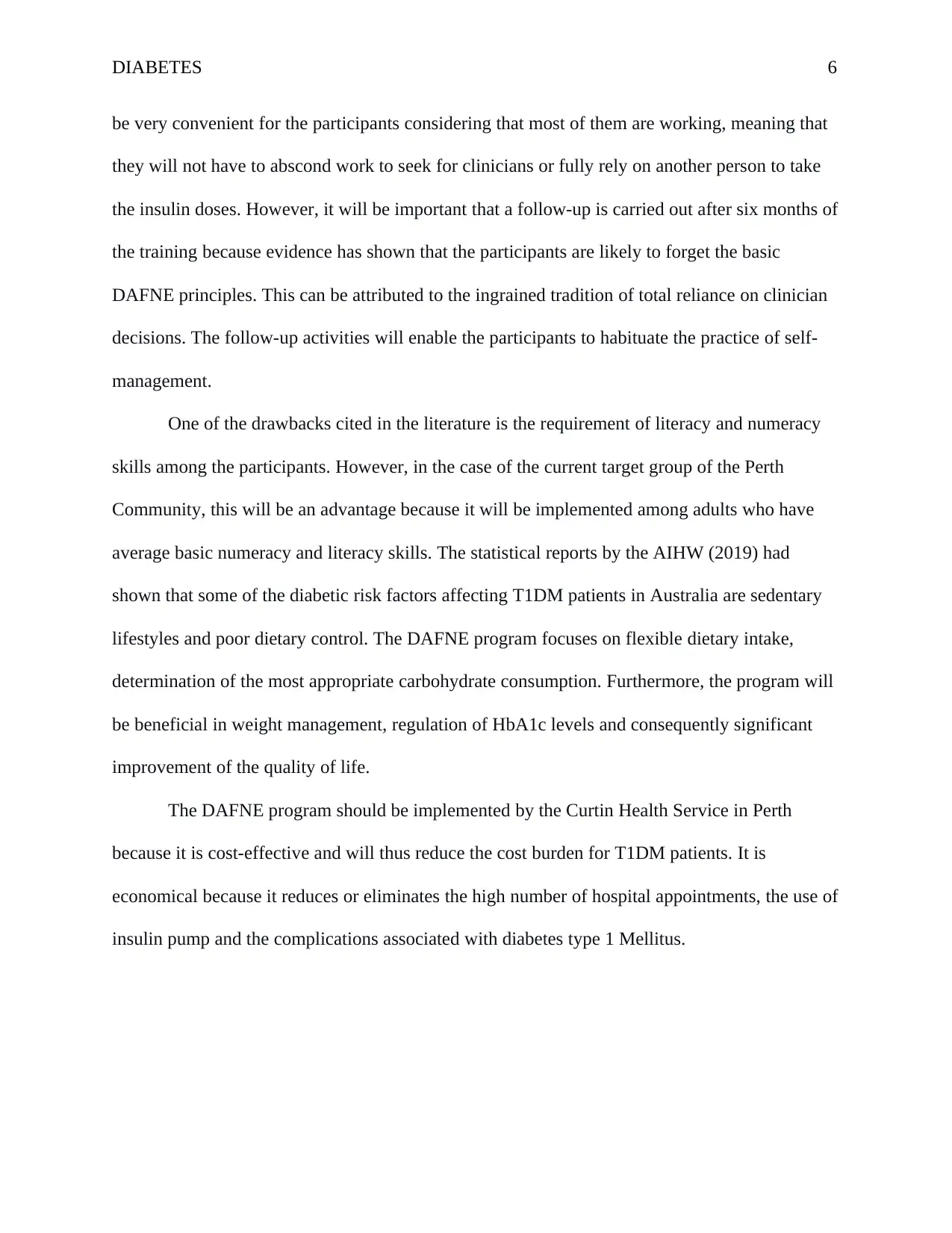
DIABETES 6
be very convenient for the participants considering that most of them are working, meaning that
they will not have to abscond work to seek for clinicians or fully rely on another person to take
the insulin doses. However, it will be important that a follow-up is carried out after six months of
the training because evidence has shown that the participants are likely to forget the basic
DAFNE principles. This can be attributed to the ingrained tradition of total reliance on clinician
decisions. The follow-up activities will enable the participants to habituate the practice of self-
management.
One of the drawbacks cited in the literature is the requirement of literacy and numeracy
skills among the participants. However, in the case of the current target group of the Perth
Community, this will be an advantage because it will be implemented among adults who have
average basic numeracy and literacy skills. The statistical reports by the AIHW (2019) had
shown that some of the diabetic risk factors affecting T1DM patients in Australia are sedentary
lifestyles and poor dietary control. The DAFNE program focuses on flexible dietary intake,
determination of the most appropriate carbohydrate consumption. Furthermore, the program will
be beneficial in weight management, regulation of HbA1c levels and consequently significant
improvement of the quality of life.
The DAFNE program should be implemented by the Curtin Health Service in Perth
because it is cost-effective and will thus reduce the cost burden for T1DM patients. It is
economical because it reduces or eliminates the high number of hospital appointments, the use of
insulin pump and the complications associated with diabetes type 1 Mellitus.
be very convenient for the participants considering that most of them are working, meaning that
they will not have to abscond work to seek for clinicians or fully rely on another person to take
the insulin doses. However, it will be important that a follow-up is carried out after six months of
the training because evidence has shown that the participants are likely to forget the basic
DAFNE principles. This can be attributed to the ingrained tradition of total reliance on clinician
decisions. The follow-up activities will enable the participants to habituate the practice of self-
management.
One of the drawbacks cited in the literature is the requirement of literacy and numeracy
skills among the participants. However, in the case of the current target group of the Perth
Community, this will be an advantage because it will be implemented among adults who have
average basic numeracy and literacy skills. The statistical reports by the AIHW (2019) had
shown that some of the diabetic risk factors affecting T1DM patients in Australia are sedentary
lifestyles and poor dietary control. The DAFNE program focuses on flexible dietary intake,
determination of the most appropriate carbohydrate consumption. Furthermore, the program will
be beneficial in weight management, regulation of HbA1c levels and consequently significant
improvement of the quality of life.
The DAFNE program should be implemented by the Curtin Health Service in Perth
because it is cost-effective and will thus reduce the cost burden for T1DM patients. It is
economical because it reduces or eliminates the high number of hospital appointments, the use of
insulin pump and the complications associated with diabetes type 1 Mellitus.
⊘ This is a preview!⊘
Do you want full access?
Subscribe today to unlock all pages.

Trusted by 1+ million students worldwide
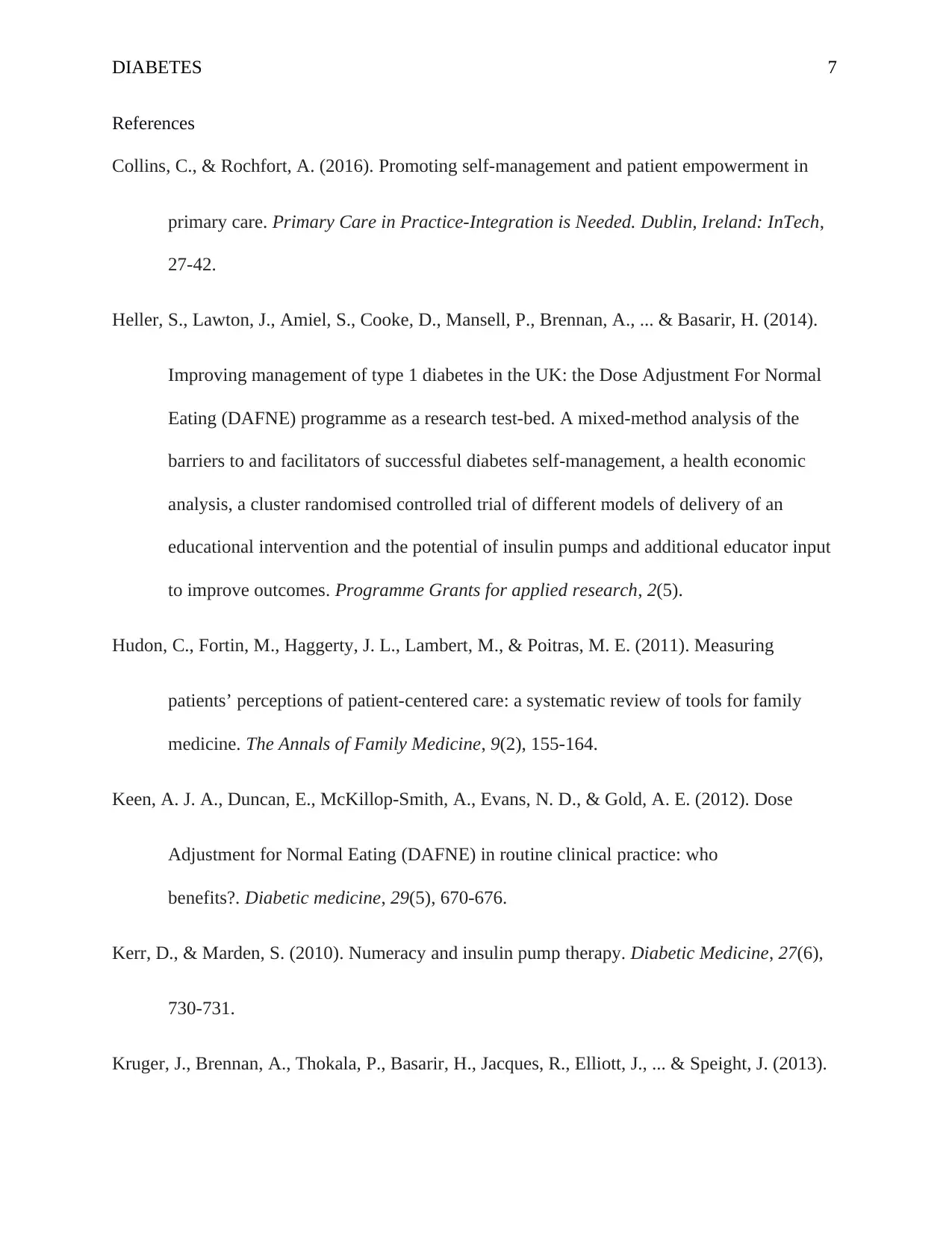
DIABETES 7
References
Collins, C., & Rochfort, A. (2016). Promoting self-management and patient empowerment in
primary care. Primary Care in Practice-Integration is Needed. Dublin, Ireland: InTech,
27-42.
Heller, S., Lawton, J., Amiel, S., Cooke, D., Mansell, P., Brennan, A., ... & Basarir, H. (2014).
Improving management of type 1 diabetes in the UK: the Dose Adjustment For Normal
Eating (DAFNE) programme as a research test-bed. A mixed-method analysis of the
barriers to and facilitators of successful diabetes self-management, a health economic
analysis, a cluster randomised controlled trial of different models of delivery of an
educational intervention and the potential of insulin pumps and additional educator input
to improve outcomes. Programme Grants for applied research, 2(5).
Hudon, C., Fortin, M., Haggerty, J. L., Lambert, M., & Poitras, M. E. (2011). Measuring
patients’ perceptions of patient-centered care: a systematic review of tools for family
medicine. The Annals of Family Medicine, 9(2), 155-164.
Keen, A. J. A., Duncan, E., McKillop‐Smith, A., Evans, N. D., & Gold, A. E. (2012). Dose
Adjustment for Normal Eating (DAFNE) in routine clinical practice: who
benefits?. Diabetic medicine, 29(5), 670-676.
Kerr, D., & Marden, S. (2010). Numeracy and insulin pump therapy. Diabetic Medicine, 27(6),
730-731.
Kruger, J., Brennan, A., Thokala, P., Basarir, H., Jacques, R., Elliott, J., ... & Speight, J. (2013).
References
Collins, C., & Rochfort, A. (2016). Promoting self-management and patient empowerment in
primary care. Primary Care in Practice-Integration is Needed. Dublin, Ireland: InTech,
27-42.
Heller, S., Lawton, J., Amiel, S., Cooke, D., Mansell, P., Brennan, A., ... & Basarir, H. (2014).
Improving management of type 1 diabetes in the UK: the Dose Adjustment For Normal
Eating (DAFNE) programme as a research test-bed. A mixed-method analysis of the
barriers to and facilitators of successful diabetes self-management, a health economic
analysis, a cluster randomised controlled trial of different models of delivery of an
educational intervention and the potential of insulin pumps and additional educator input
to improve outcomes. Programme Grants for applied research, 2(5).
Hudon, C., Fortin, M., Haggerty, J. L., Lambert, M., & Poitras, M. E. (2011). Measuring
patients’ perceptions of patient-centered care: a systematic review of tools for family
medicine. The Annals of Family Medicine, 9(2), 155-164.
Keen, A. J. A., Duncan, E., McKillop‐Smith, A., Evans, N. D., & Gold, A. E. (2012). Dose
Adjustment for Normal Eating (DAFNE) in routine clinical practice: who
benefits?. Diabetic medicine, 29(5), 670-676.
Kerr, D., & Marden, S. (2010). Numeracy and insulin pump therapy. Diabetic Medicine, 27(6),
730-731.
Kruger, J., Brennan, A., Thokala, P., Basarir, H., Jacques, R., Elliott, J., ... & Speight, J. (2013).
Paraphrase This Document
Need a fresh take? Get an instant paraphrase of this document with our AI Paraphraser
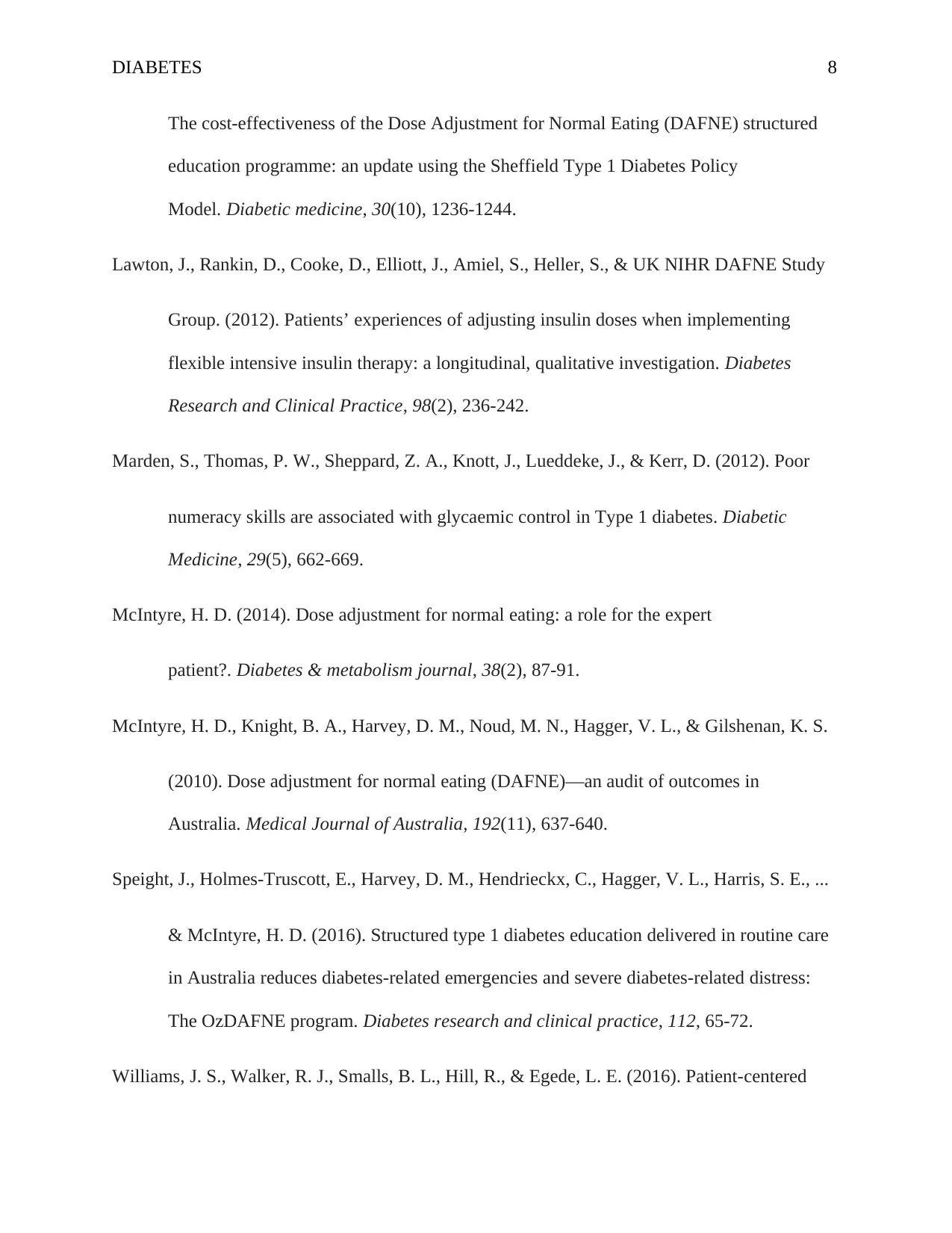
DIABETES 8
The cost‐effectiveness of the Dose Adjustment for Normal Eating (DAFNE) structured
education programme: an update using the Sheffield Type 1 Diabetes Policy
Model. Diabetic medicine, 30(10), 1236-1244.
Lawton, J., Rankin, D., Cooke, D., Elliott, J., Amiel, S., Heller, S., & UK NIHR DAFNE Study
Group. (2012). Patients’ experiences of adjusting insulin doses when implementing
flexible intensive insulin therapy: a longitudinal, qualitative investigation. Diabetes
Research and Clinical Practice, 98(2), 236-242.
Marden, S., Thomas, P. W., Sheppard, Z. A., Knott, J., Lueddeke, J., & Kerr, D. (2012). Poor
numeracy skills are associated with glycaemic control in Type 1 diabetes. Diabetic
Medicine, 29(5), 662-669.
McIntyre, H. D. (2014). Dose adjustment for normal eating: a role for the expert
patient?. Diabetes & metabolism journal, 38(2), 87-91.
McIntyre, H. D., Knight, B. A., Harvey, D. M., Noud, M. N., Hagger, V. L., & Gilshenan, K. S.
(2010). Dose adjustment for normal eating (DAFNE)—an audit of outcomes in
Australia. Medical Journal of Australia, 192(11), 637-640.
Speight, J., Holmes-Truscott, E., Harvey, D. M., Hendrieckx, C., Hagger, V. L., Harris, S. E., ...
& McIntyre, H. D. (2016). Structured type 1 diabetes education delivered in routine care
in Australia reduces diabetes-related emergencies and severe diabetes-related distress:
The OzDAFNE program. Diabetes research and clinical practice, 112, 65-72.
Williams, J. S., Walker, R. J., Smalls, B. L., Hill, R., & Egede, L. E. (2016). Patient-centered
The cost‐effectiveness of the Dose Adjustment for Normal Eating (DAFNE) structured
education programme: an update using the Sheffield Type 1 Diabetes Policy
Model. Diabetic medicine, 30(10), 1236-1244.
Lawton, J., Rankin, D., Cooke, D., Elliott, J., Amiel, S., Heller, S., & UK NIHR DAFNE Study
Group. (2012). Patients’ experiences of adjusting insulin doses when implementing
flexible intensive insulin therapy: a longitudinal, qualitative investigation. Diabetes
Research and Clinical Practice, 98(2), 236-242.
Marden, S., Thomas, P. W., Sheppard, Z. A., Knott, J., Lueddeke, J., & Kerr, D. (2012). Poor
numeracy skills are associated with glycaemic control in Type 1 diabetes. Diabetic
Medicine, 29(5), 662-669.
McIntyre, H. D. (2014). Dose adjustment for normal eating: a role for the expert
patient?. Diabetes & metabolism journal, 38(2), 87-91.
McIntyre, H. D., Knight, B. A., Harvey, D. M., Noud, M. N., Hagger, V. L., & Gilshenan, K. S.
(2010). Dose adjustment for normal eating (DAFNE)—an audit of outcomes in
Australia. Medical Journal of Australia, 192(11), 637-640.
Speight, J., Holmes-Truscott, E., Harvey, D. M., Hendrieckx, C., Hagger, V. L., Harris, S. E., ...
& McIntyre, H. D. (2016). Structured type 1 diabetes education delivered in routine care
in Australia reduces diabetes-related emergencies and severe diabetes-related distress:
The OzDAFNE program. Diabetes research and clinical practice, 112, 65-72.
Williams, J. S., Walker, R. J., Smalls, B. L., Hill, R., & Egede, L. E. (2016). Patient-centered
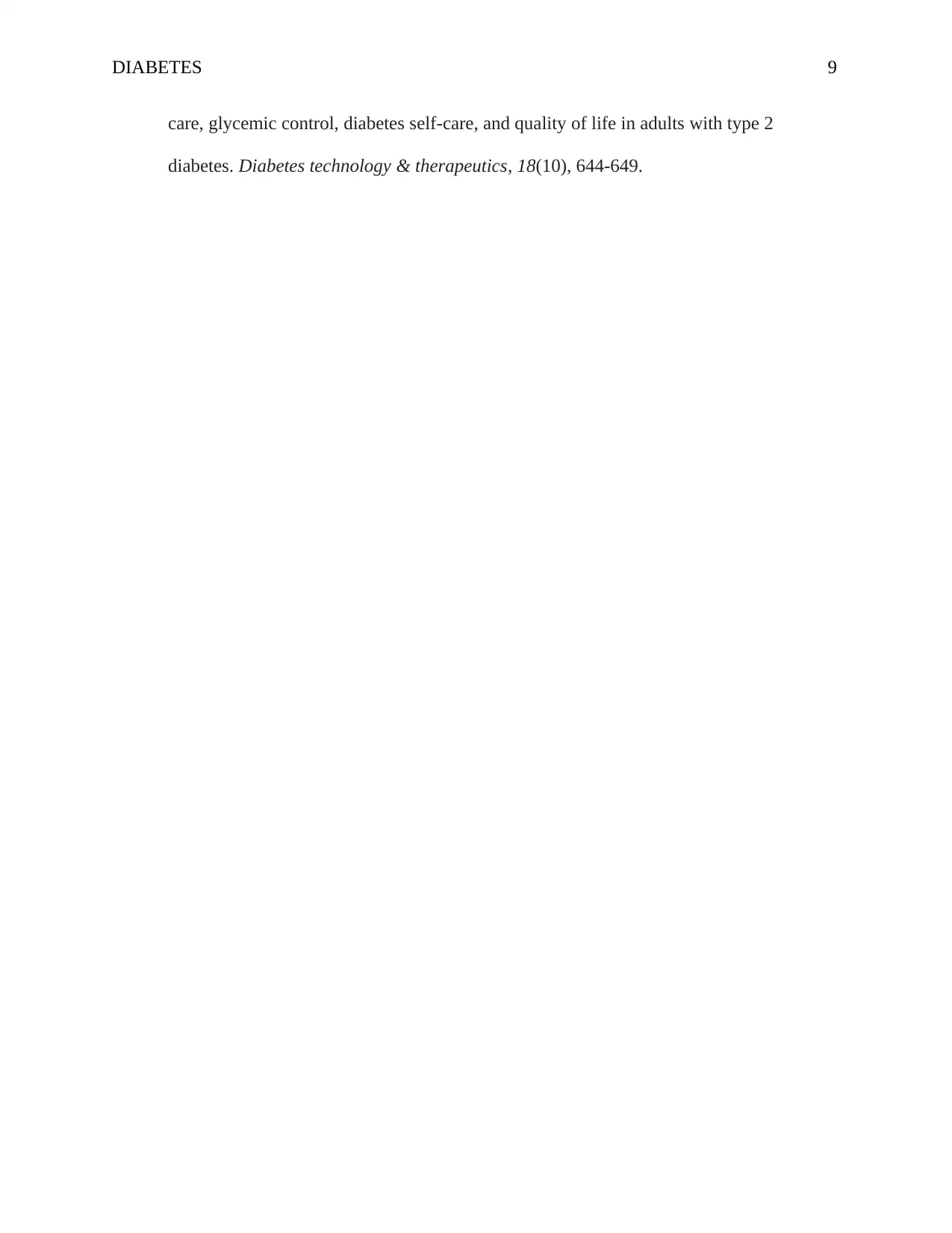
DIABETES 9
care, glycemic control, diabetes self-care, and quality of life in adults with type 2
diabetes. Diabetes technology & therapeutics, 18(10), 644-649.
care, glycemic control, diabetes self-care, and quality of life in adults with type 2
diabetes. Diabetes technology & therapeutics, 18(10), 644-649.
⊘ This is a preview!⊘
Do you want full access?
Subscribe today to unlock all pages.

Trusted by 1+ million students worldwide
1 out of 9
Related Documents
Your All-in-One AI-Powered Toolkit for Academic Success.
+13062052269
info@desklib.com
Available 24*7 on WhatsApp / Email
![[object Object]](/_next/static/media/star-bottom.7253800d.svg)
Unlock your academic potential
Copyright © 2020–2025 A2Z Services. All Rights Reserved. Developed and managed by ZUCOL.





